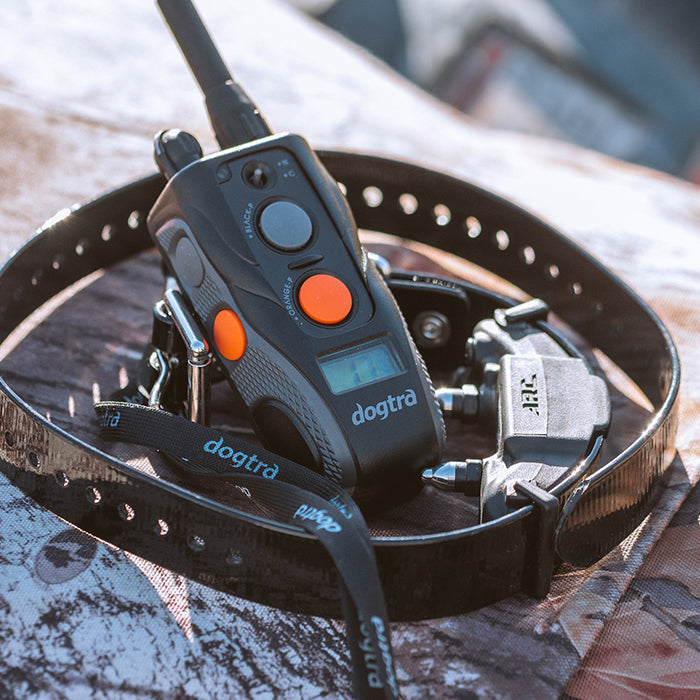WHEN TO START E-COLLAR TRAINING: A GUIDE FOR DOG OWNERS

To use or not to use an E-collar…that is the question! A question many owners ask but don’t ever find the real answer to. Deciding when to start e-collar training for your dog can be a difficult decision for any dog owner. E-collar training, also known as electronic collar training, is a controversial topic among pet owners, and it's essential to make an informed decision before starting this type of training. E-collar training can be an effective way to train your dog, but it's crucial to understand when it's appropriate to use this tool. Keep reading to learn when you should introduce your dog to a remote collar training.
Why Use an E-Collar
The bottom line is that the remote training collar works to offer better, clearer, more efficient communication between you and your dog. It allows an almost instant channel to offer guidance and reinforcement of commands your dog already has been taught. Providing clarity and instant reinforcement in any situation and at any distance. So, in theory, an E-collar is a good choice for every dog owner, but are you right about the E-collar is the key question?
Is a Remote Collar the Right Choice for You?
Let’s start by first discussing your goals. Not just your training goals but the goals that you have in mind for life with your dog. A remote training collar can help to open up freedom for your dog, allowing more hikes, beach visits, or social time with other dogs. But what if you aren’t an outdoorsy person? An E-collar can also get you more control on walks in the neighborhood and the ability to peacefully open your door to get your pizza delivered.
Teach Basic Behaviors
Your dog will need to be mentally prepared in the form of foundational, obedience training before beginning to condition the E-collar. That means the behaviors you plan to enforce using static stimulation need to be in place long before you start to use your E-collar. This is done through many repetitions with your dog on leash. You may need to seek the help of a professional trainer in your area to reach the level of obedience necessary to begin E-collar training. These all too important building blocks will set your dog up for success. The better your dog’s obedience is on the leash, the easier the e-collar conditioning will be.
Be Prepared for Commitment
You, the owner, will have to make a commitment to continue training with your dog. This means continuing to educate your dog both on and off the E-collar in a way that helps your dog reach their full potential. It is not fair to your dog to slap an E-collar on them once every couple of months when you expect better behavior. Your dog’s training is something that has to be maintained. This means if you don’t use it, you lose it! In order for this valuable form of communication to be utilized correctly, your dog will require a working knowledge of what you want from them. A knowledge that only comes from continuing education.
How to Use an E-Collar
You, the owner, will also require training in how to properly use the E-collar! This can come in many different ways such as guidance from a local trainer, online platforms, or from Dogtra resources. You want to have a comprehensive understanding of your unit:
- Turning on the collar and transmitter.
- Changing the levels.
- Learning your dog’s working levels and understanding that the levels change based on many factors.
- Identify the Nick and Continuous static stimulation buttons and learn which is best suited for your dog.
- How to comfortably hold the transmitter, so you do not touch the antenna and thus interrupt signal.
- The placement of the collar on your dog, high on the neck and off to one side of the windpipe is best.
In order to be successful at this, we suggest working with your unit when it is not on your dog. Timing is extremely important when implementing the static stimulation. Stimulation applied too soon or too late will confuse the dog. Master this skill long before you have to actually use it!
When to Start E-Collar Training
E-collar training can be a powerful tool for dog owners, but it's important to determine if it's the right approach for your pet before starting. To determine when to start e-collar training, you should first evaluate your dog's behavior and temperament. Dogs that are fearful or aggressive may not respond well to this type of training and may need alternative methods. Additionally, puppies under six months old may not have developed the necessary skills or maturity to handle e-collar training. If you determine that e-collar training is a good fit for your dog, it's important to introduce the collar gradually and ensure that you use it correctly. Positive reinforcement training should always be the foundation of any training program, and e-collar use should be viewed as a supplement to, rather than a replacement for, positive training methods. By following these guidelines, you can ensure that e-collar training is a safe and effective way to train your dog.
Final Thoughts
In conclusion, e-collar training can be an effective way to train your dog, but it's not suitable for every pet. It's essential to evaluate your dog's behavior and readiness to determine if e-collar training is appropriate. Starting at the right age, introducing the collar gradually, and using it correctly are also key factors in making e-collar training a success. Additionally, remember that remote collar training should be viewed as a supplement to positive reinforcement training, not a replacement for it. By taking these considerations into account, you can make an informed decision about when to start e-collar training and ensure that your dog receives the best possible training to live a happy, healthy life.





